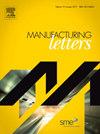融合 IK:利用混合深度学习和进化方法解决逆运动学问题
IF 1.9
Q3 ENGINEERING, MANUFACTURING
引用次数: 0
摘要
逆运动学是机器人操纵的一个核心方面。本文介绍了一种结合深度学习与进化算法的机器人逆运动学(IK)求解方法,包括关节型工业机器人。Fusion IK 将机械手的目标值和当前关节值传入神经网络,然后利用神经网络的结果为进化算法 Bio IK 提供种子,完成逆运动学问题的求解。Fusion IK 可以解决机器人的位置和方向问题,同时试图最大限度地减少关节运动时间。我们在一个六自由度铰接式工业机器人和一个 20 自由度机器人上测试了 Fusion IK 与其基础算法 Bio IK 之间的比较,以探索 Fusion IK 所产生的移动时间。比较结果表明,在六自由度铰接式机器人上,Fusion IK 算法的变体与其底层进化 Bio IK 算法的结果相当,而在 20 自由度机器人上则有所改进,无需额外调整超参数。研究结果表明,Fusion IK 在运动时间和所获解决方案质量方面具有实际价值,有待进一步研究,特别是在更高自由度的机器人上。本文章由计算机程序翻译,如有差异,请以英文原文为准。
Fusion IK: Solving inverse kinematics using a hybridized deep learning and evolutionary approach
Inverse kinematics is a core aspect of robot manipulation. This paper presents an approach to solving Inverse Kinematics (IK) for robots, including articulated industrial ones, combining deep learning with an evolutionary algorithm. Fusion IK passes the manipulator’s target and current joint values into a neural network, the results of which are then used to seed an evolutionary algorithm, Bio IK, to complete the solution of the inverse kinematics problem. Fusion IK allows for solving the position and orientation of the robot while attempting to minimize joint movement times. Comparisons between Fusion IK and its underlying algorithm Bio IK are tested on a six-degree-of-freedom articulated industrial robot as well as a 20-degree-of-freedom robot to explore the move times that Fusion IK produces. The comparisons show that the variations of the Fusion IK algorithm show comparable results to its underlying evolutionary Bio IK algorithm on a six-degrees-of-freedom articulated robot and improvements on a 20-degree-of-freedom robot without any additional hyperparameter tuning. The results show that Fusion IK could be of real value regarding the movement time and the quality of the obtained solutions upon further research, especially with higher degree-of-freedom robots.
求助全文
通过发布文献求助,成功后即可免费获取论文全文。
去求助
来源期刊

Manufacturing Letters
Engineering-Industrial and Manufacturing Engineering
CiteScore
4.20
自引率
5.10%
发文量
192
审稿时长
60 days
 求助内容:
求助内容: 应助结果提醒方式:
应助结果提醒方式:


